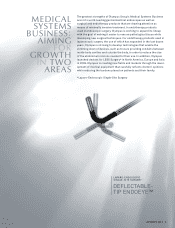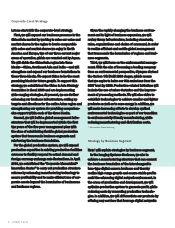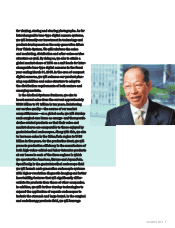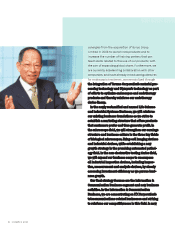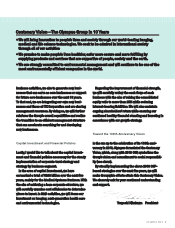Olympus 2010 Annual Report Download - page 8
Download and view the complete annual report
Please find page 8 of the 2010 Olympus annual report below. You can navigate through the pages in the report by either clicking on the pages listed below, or by using the keyword search tool below to find specific information within the annual report.
6 OLYMPUS 2010
Corporate-Level Strategy
Let me start with the corporate-level strategy.
First, we will expand our business presence in the
China/Asia market by working to raise our sales and
market shares in the region to levels comparable
with sales and market shares we enjoy in North
America and Europe, two of our three current major
areas of operation, which are rounded out by Japan.
We will divide the China/Asia region into three
blocks—China, Southeast Asia and India—and will
strengthen and expand our business foundations in
these three blocks. We expect China to be the most
promising block for future growth. To support this
strategy, we established the China & Asia Strategy
Committee in fiscal 2009 and are implementing
wide-ranging strategies. At present, we are further
enhancing our business infrastructure, setting up
targets and directions for the entire Asian region and
strengthening our system for providing comprehen-
sive support within each of the three blocks.
Second, we will build a global management infra-
structure that will be implemented within the first
two years of the five-year management plan with
the aims of establishing flexible global production
system that transcends business segments and
reinforcing the business foundation.
For the global production system, we will expand
production capacities in existing production facilities
overseas to flexibly respond to actual demand and
foreign currency exchange rate fluctuations. In April
2010, we established the “Corporate Monozukuri*
Innovation Center” to carry out production structure
reforms by enhancing manufacturing technology to
secure profitability and to make efficient use of cor-
porate assets beyond the boundaries of businesses
and business regions.
Given the rapidly changing the business environ-
ment and in light of business expansion, we will
review Group infrastructure, including standards,
rules, organizations and chains of command, in order
to realize efficient and mobile global management
that transcends the boundaries of regions and busi-
ness segments.
Third, we will focus on the environmental manage-
ment. With the aim of becoming a leading company
from an environmental perspective, Olympus devised
the Carbon 1/2 (Half) 2020 slogan, which means
that we aspire to halve our CO2 emissions from the
2007 level by 2020. Production-related initiatives will
include the use of micro-factories and the improve-
ment of processing methods. We will also strive to
establish technologies to achieve smaller and lighter
products as well as to save energy. In addition, we
will make increasing efforts to develop cyclical
environmental technologies as part of our transition
to environmentally friendly manufacturing, while
reducing manufacturing and distribution costs.
*
Monozukuri
: Manufacturing
Strategy by Business Segment
Now I will explain strategies by business segment.
In the Imaging Systems Business, we aim to
achieve a manufacturing structure that can cement
the business foundation of the interchangeable
lens-type digital camera business and thereby
realize high-range growth and secure stable profits
amid the advancing digital network environment. In
the areas of production and development, we will
optimize production system to generate profit, while
reducing costs by renovating production technolo-
gies. In addition, we will differentiate our products by
offering new services that leverage digital networks



